Patagonia, Argentina
Patagonia (the southern end of South America) is one of the most remote parts of the world where Lithuanian heritage exists. Population density of Patagonia is merely 2 people per. Sq. km. Moreover, Patagonia was conquered by Europeans late in history – only by the 19th century. Thus the first Patagonian cities were established in a time when Lithuanians already began their massive migration into the Americas and Lithuanians thus participated in the creation of such cities.
Patagonia is partitioned between Argentina and Chile. Almost all Patagonia’s Lithuanians and Lithuanian heritage are located in the Argentine part.
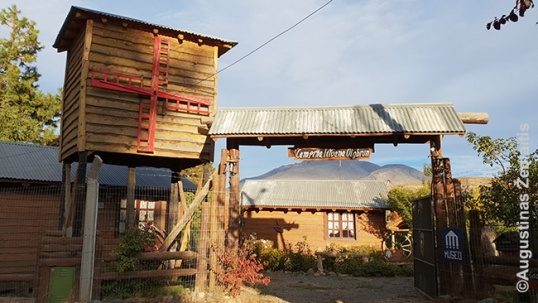
Entrance to the Lithuanian farmstead of Esquel
Esquel Olgbrun Lithuanian farmstead-museum
The Olgbrun Lithuanian farmstead-museum of Esquel is both the newest piece of Lithuania in Patagonia and also the largest. A complex of nice wooden buildings is used for tourism (the houses may be rented) in the area rich in lakes, Andes mountains and some of the oldest trees in the world.

Esquel Lithuanian farmstead. House ‘Trakai’ is on the right while hills are visible on the left
Each of the houses of the farmstead are named after some Lithuanian town or city (Vilnius, Trakai, Palanga, Marijampolė, Šeštokai). Lithuanian symbols are available both inside and outside. Farmstead’s souvenir shop also has lots of both Lithuanian-inspired and Argentine items.

House Palanga of the Lithuanian farmstead
The real heart of the complex is the Olgbrun Lithuanian museum. It has collected many items from closed-down Lithuanian-Argentine institutions, Lithuanian diplomatic and consular missions in Argentina, as well as Lithuanian-Argentine families. There are Lithuanian books (even those published in the USA in the 19th century while Lithuanian language was still banned by the Russian Imperial government in Lithuania itself), musical records, technics. There is also lots of information about the life of Lithuanian-Argentines and the Lithuanian sites in Argentina. The museum is interesting both to the Lithuanians from Lithuania and the Argentinians.
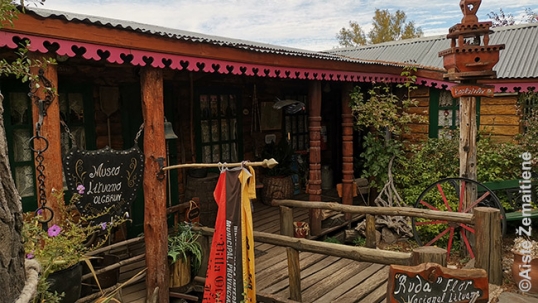
The building of Esquel Lithuanian museum
The museum consists of five halls. The first hall includes the main exhibits of the museum – the exhibition of “Argentinos lietuvių balsas” (Lithuanian-Argentine Voice), the prime Lithuanian newspaper of Argentina that used to be published between the years 1927 and 2001. There are three authentic ~100-year-old pieces of machinery used to print the newspaper, various examples of the newspaper, pictures from the publishing house and the wider Lithuanian-Argentine community. There are also items from other Lithuanian-Argentine institutions such as the stamping machinery of the pre-WW2 consulate of Lithuania in Buenos Aires (which is now used to make museum stamps for tourists) or the plaque that once marked the Lithuanian embassy to Argentina (closed in 2012).
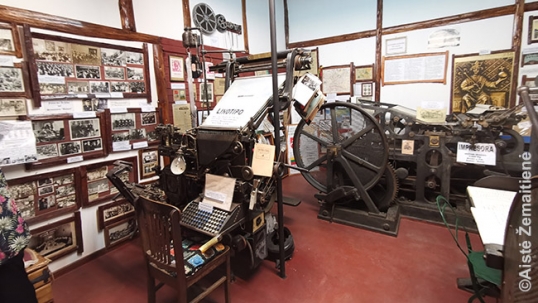
Argentinos lietuvių balsas exhibits in the Lithuanian museum of Esquel
The second hall of the museum has old Lithuanian-Argentine books and more information about the Lithuanians of Patagonia as well as the owners of the museum. The museum was established by Bronius (Bruno) and Olga Lukoševičius who moved to Esquel from Buenos Aires in 1985. Both have been born in Argentina. Only Bronius is a Lithuanian, however, Olga also helps a lot in the creation and operation of the museum. When Lithuania was re-establishing independence ~1990 the Lukoševičius family used to inform the Argentine people and media about what is going on in Lithuania. They even created an “Esquel Sąjudis” organization, named after Sąjūdis, the Lithuanian organization that was instrumental in restoring the independence after the Soviet occupation decades. Esquel Sąjūdis is now commemorated by a plaque at the museum entrance. In 1998, when the museum owners visited Lithuania, they met Vytautas Landsbergis who is called the patriarch of Lithuanian independence restoration; he is also well introduced in the museum. At that year, while visiting the Rumšiškės folk culture museum in Lithuania, Lukoševičius saw a house very similar to one where his parents lived. Later Lukoševičius learned that it is indeed the same house (Rumšiškės museum used to take old wooden houses and relocate them into the museum territory from all over Lithuania). It was then Lukoševičius had the idea of creating a similar museum in Patagonia. The house where the museum is in, therefore, is called “Rumšiškės” and it was built to remind the Bronius’s parents house that stands in Rumšiškės. In the museum, the names of the other houses of Esquel Lithuanian farmstead are also explained. There is also more information about the journey of self-discovery Bronius took in Lithuania and images from that journey.
The third hall of the museum has information about the famous Lithuanian-Argentinians and their influence in the Argentine history / Patagonian colonization.
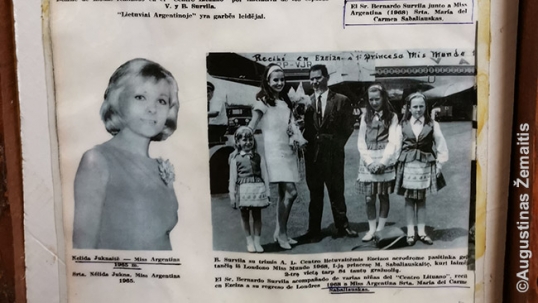
Interesting details about the Lithuanian participation in Argentine life. Newspaper clippings about a Lithuanian girl who represented Argentina in Miss World pageant in 1965
Museum’s fourth hall is full of information about Lithuania. Ethnic clothes, pieces of amber (some with fossils), Lithuanian Litas banknotes, articles from the local press about the museum, images of people who visited the museum from Lithuania (among them politicians, diplomats). It became a nice tradition for Lithuanians who travel by car across Patagonia to also visit the Lithuanian farmstead and museum of Esquel. It is not difficult as Esquel is on one of merely two paved north-south roads in Argentina (the famous 40th road, Ruta 40, that has been compared to Road 66 of the United States although it is even more atmospheric).
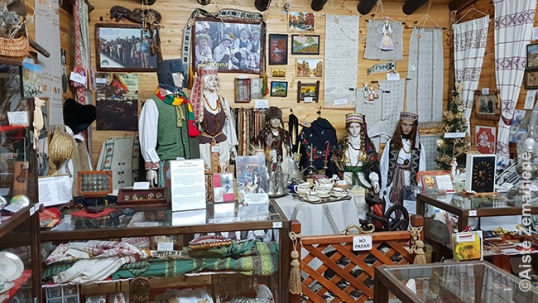
Lithuania hall of the Esquel Lithuanian museum
The fifth and final hall of the Esquel Lithuanian museum is dedicated to the natural sciences and includes stones, shells, fossils and more. Some things there are from Lithuania but far from everything – in fact, officially the entire museum is called “Museum of Lithuania and natural sciences”. The connection is Ignacio Domeyko (Ignas Domeika), a geologist who emigrated from Lithuania to Chile and became famous there. A part of the hall is dedicated to him and various places named after him in Chile.
In the museum, visitors may also listen to old Lithuanian records.
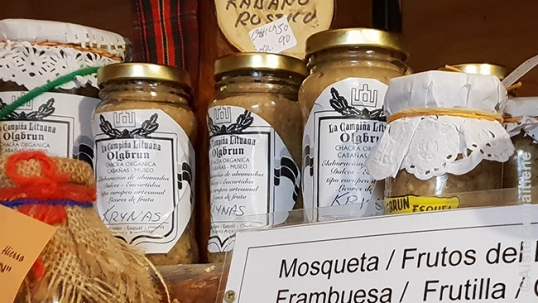
Items marked in Lithuanian symbols for sale at the museum’s shop. Many of them have been created in the ecological farm owned by museum owners
There are Lithuanian symbols on the exterior of the museum as well. Stork, the national bird of Lithuania. A possibility to look into a traditional farmstead of a 19th-century Lithuanian family. Interpretations of chapel-post and Rūpintojėlis, two forms of traditional Lithuanian crafts. All that is not simply exhibits – these items also help create the atmosphere of the entire farmstead.
Unlike many other Lithuanian museums abroad, the Esquel one is officially open and has regular opening hours. It is included in “Tripadvisor” and is primarily oriented at the people of Argentina who like to visit it (all the information in the museum is in Spanish, except for the old books and documents themselves). However, it is also interesting to Lithuanians from elsewhere.
In 2005 the owners of the museum ensured that one of the Esquel crossroads would be renamed “Lithuanian Square”. A wooden Lithuanian square post was erected there. Initially the post was made of marble, however, that one was stolen and then replaced by a cheaper wooden one.
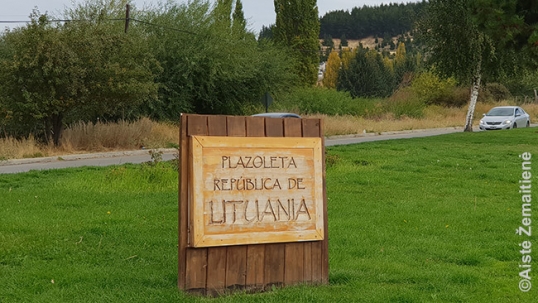
Lithuanian square commemorative plaque in Esquel
Sarmiento and its Šlapelis settler family
Although the massive wave of Lithuanian migration to Argentina took place in years 1925-1930, some 5000 Lithuanians lived in Argentina beforehand. Argentina was rich then as well – however, before World War 1, it was rather easy to emigrate to the USA and so Lithuanian migrants used to choose the USA as the destination. Still, some chose Argentina.
At that time Patagonia (Argentina’s south) was just conquered from Native Americans during a war known as “Conquest of the Desert”. Patagonia lacked cities or towns and the Argentine government, wishing to populate the region (that could have been potentially disputed by Chile or the imperial powers of Europe), would give the land for free to people (including immigrants who would become subjects of Argentina).
The most famous “Lithuanian” town of Patagonia is Sarmiento (pop. 8000). One of its founders was Izidorius Šlapelis, a Lithuanian who was first expelled by the Russian Empire (which ruled Lithuania back then) to Siberia but managed to escape from there, eventually reaching Argentina in 1877, receiving land in Patagonia and settling there with his family of 10.
Later, Šlapelis invited more Lithuanian families into Patagonia and the Šlapelis family itself gave Sarmiento and Argentina more great personalities who inscribed their own names into the maps of Argentina. Sarmiento has a monument to Kazimieras Šlapelis (without any name marked, however). Kazimieras was a daredevil pilot grandson of Izidorius who, according to local histories, used to fly patients for free to the far away hospitals, throw candies to the local kids out of his airplane. He also had many books about Lithuania and its freedom struggle. Sarmiento has Šlapelis street (written as Szlapeliz; because Šlapelis emigrated at the time there was still no standard Lithuanian orthography, the spelling of his name varies), Šlapelis district.
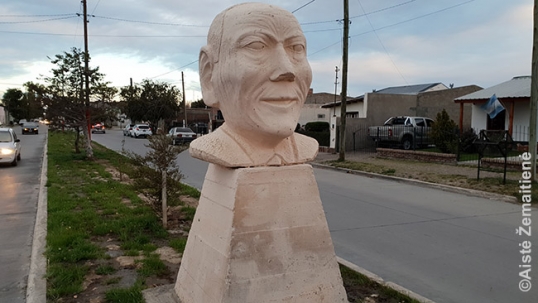
The bust of Kazimieras (Casimiro) Šlapelis in Sarmiento
Not far away from Sarmiento, there is a V. Šlapelis petrified forest (an open space full of fossilized trees), a hill known as Cerro Szlapelis. These sites are more difficult to visit as paved roads are rare in Patagonia and the gravel roads to far-away places are difficult to pass without an SUV.
Sarmiento museum has a multitude of Šlapelis-related exhibits. Kazimieras gifted many of his family items to the museum. There is even a poem dedicated to him (called “Condor of the skies”), family photos, newspaper clippings about his flights (among the first ones in entire Patagonia), etc. Kazimieras Šlapelis became somewhat of a legend of Sarmiento. Stories about him have been printed in the city history book and even mentioned in adverts of the local candy shop.

Šlapelis family pictures in Sarmiento museum. Pictures of this type were popular in the 19th-20th turn-of-the-centuries
Like many cities and towns of Patagonia, Sarmiento has an Immigrant square with flags from the countries that gave the most immigrants to the area (one of those flags is Lithuanian). The masts of the flags are like rays from a center where Argentine flags waves.
Another Kazimieras Šlapelis street is in Comodoro Rivadavia city (the closest larger city to Sarmiento). Kazimieras Šlapelis used to fly to Comodoro Rivadavia with his plane. By the way, even the street name plaques on the same street have different variants of his name: one plaque writes it as “Casimiro Szlapelis”, another one as “Casimiro Slapelis”. Commodoro Rivadavia also had a larger Lithuanian immigrant community in the first half of the 20th century. This city also has Lituania Street.
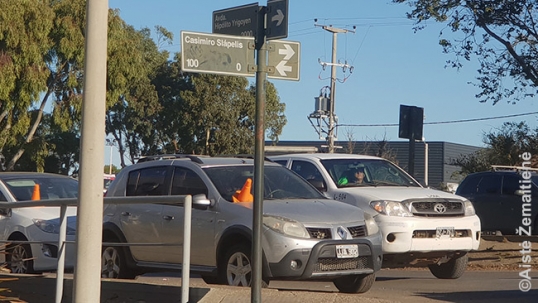
Kazimieras Šlapelis street in Commodoro Rivadaivia. Casimiro Slapelis version of his name (on the other crossroad, Szlapelis version is used).
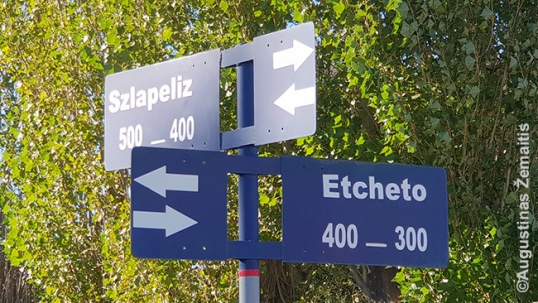
Šlapelis street in Sarmiento
Another city where Šlapelis used to fly to was Alto Rio Senguer, a town even more remote than Sarmiento (population ~1500). The local airport has been named D. Casimiro Szlapelis Airport and the town also has Casimiro Szlapelis agricultural school
Among the families invited to Patagonia by Izidorius Šlapelis were Baltuška family. Two farms in the area are still named after it.




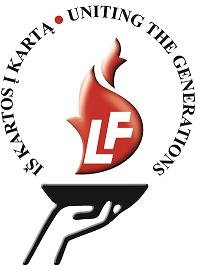

May 9th, 2019 - 13:02
Yra įdomi knyga apie lietuvius Patagonijoje. Stilius vietomis sunkokas skaityti, tačiau informacija pritraukianti: http://leidykla.vda.lt/lt/leidinys/1492769009/kupiskenai-patagonijos-kolonistai
July 5th, 2020 - 20:48
Salve os descendentes Família Slapelis